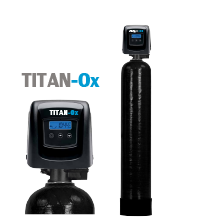Heavy Metals (incl. Lead and Iron)

TITAN-Ox TOx-5800SXT-12-52 Arsenic and Heavy Metal Reduction Filter | List Price: US$ Our Price: US$2,674.00 You save: $856.00 |
Common Heavy Metal Contaminants
Cadmium occurs mostly in association with zinc and gets into water from corrosion of zinc-coated ("galvanized") pipes and fittings.
Antimony occurs mostly in association with lead, where it is used as a hardening agent. It gets into water from corrosion of lead pipes and fittings, but even then it is rarely detectable. More antimony is found in food than water.
Mercury is notorious as an environmental toxin, but it is not a big problem in water supplies. That's because it is found only at very low levels in water. Certain bacteria are able to transform it into methyl mercury, which is concentrated in the food chain and can cause malformations.
Thallium is as toxic as lead or mercury, but is extremely rare and not often a problem in water.
Copper at very high levels is toxic and can cause vomiting, diarrhea, loss of strength or, for serious exposure, cirrhosis of the liver. Water turns blue-green in colour as the corroded copper comes off the inside of the pipes and appears in the water as a precipitate. This reaction only occurs in a small percentage of cases.
Iron can cause rusty yellow, orange, red or brown stains on fixtures or laundry and/or cause your water to develop a metallic taste.
Manganese can cause a brown or black stain on fixtures or laundry and/or cause your water to develop a metallic taste.
Lead is the most significant of all the heavy metals because it is both very toxic and very common. It gets into water from the corrosion of plumbing materials, where lead has been used freely since Roman times. In addition, lead can be found in the solder used to join copper pipes, and in fittings and faucets made from brass.
Detecting Heavy Metals in Your Water
With the exception of iron and manganese, most heavy metals cannot be detected by sight, smell or taste. If you are concerned about heavy metals in your drinking water, you should have the water tested by a reliable chemical laboratory. First, request a copy of the most recent analysis done by the local waterworks agency, which is required by law to test and report to state or provincial authorities on a regular basis. If you have a private well, call the county environment or health office and ask if your region has any history of heavy metal problems in ground water. It is usually not necessary to test for them unless there is a history of problems.All but the newest buildings contain lead-based plumbing materials, so everyone should test for lead. A complete analysis for all heavy metals could cost more than $100, but most labs have a special $15 - $25 price for a lead test. You will need to send the lab samples of water from the tap. Take the water sample from the tap after an extended period of stagnation, for instance in the morning after leaving it overnight. Try to include two samples: one containing the very first water drawn from the tap, and one sample containing water after about 30 seconds of running.
We recommend the following treatment systems for heavy metals:
Drinking Water Systems:
Whole House Systems:
- Iron and Manganese: Whole House Iron and Manganese Filters
- Other Metals: TITAN-Ox Series Whole House Heavy Metal Reduction Filters




